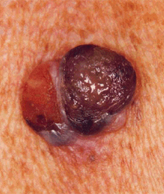Melanoma Biomarker Could Predict Response to BRAF Inhibitors
Researchers have identified a biomarker that may help physicians predict if patients with BRAF-mutant melanomas will respond to drugs designed to target BRAF.
Nodular melanoma with ulceration

Researchers have identified a biomarker that may help physicians predict if patients with BRAF-mutant melanomas will respond to drugs designed to target BRAF, according to new data presented at the AACR-NCI-EORTC International Conference on Molecular Targets and Cancer Therapeutics.
About 50% of patients with melanoma have BRAF mutations. Although selective RAF and MEK inhibitors have become valuable treatment options for these patients in recent years, many still fail to respond, or have partial or short-lived responses.
Ryan B. Corcoran, MD, PhD, a Damon Runyon clinical investigator and assistant professor at the Massachusetts General Hospital Cancer Center and Harvard Medical School in Boston, and colleagues conducted a study in BRAF-mutant melanoma cell lines in vitro and in mouse tumor xenografts to identify possible biomarkers of response.
They found that suppression of TORC1 activity as measured by decreased phosphorylation of ribosomal protein-S6 (P-S6) predicted sensitivity to therapy. In melanomas sensitive to treatment, TORC1 and P-S6 were suppressed. In contrast, TORC1 activity was maintained in those melanomas that were resistant to therapy. The researchers found that TORC1 suppression was necessary for apoptosis and tumor response in vivo.
“Our study has identified decreased phosphorylation of the protein S6 after treatment with BRAF-targeted drugs as a functional biomarker that predicts sensitivity of BRAF-mutant melanomas to these drugs,” Corcoran said in a press release.
They then analyzed S6 phosphorylation in tumor biopsies obtained from nine patients with BRAF-mutant melanomas before and after they had initiated treatment with a BRAF-targeted drug. Six patients had lower levels of tumor cell S6 phosphorylation after treatment compared with before treatment, and this was associated with an almost fivefold improvement in progression-free survival.
Finally, Corcoran and colleagues were able to monitor P-S6 changes in patients’ tumor cells by using real-time, multiplexed, quantitative immunofluorescence microscopy of fine-needle aspiration biopsies obtained from patients before and during initial therapy with a RAF inhibitor.
“Importantly, we have developed a minimally invasive way to rapidly monitor post-treatment changes in S6 phosphorylation in patients’ tumor cells,” Corcoran said. “As a result, we think that we can quickly determine whether or not a patient is likely to respond to a BRAF-targeted drug and help speed up treatment decisions, although we need to verify this in larger clinical studies.”
Newsletter
Stay up to date on recent advances in the multidisciplinary approach to cancer.